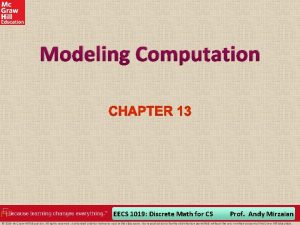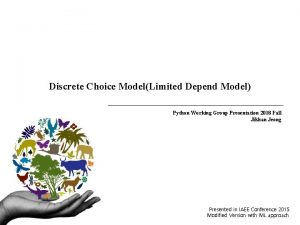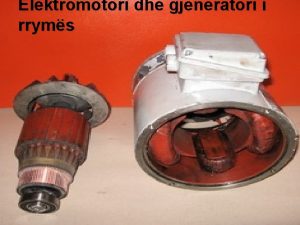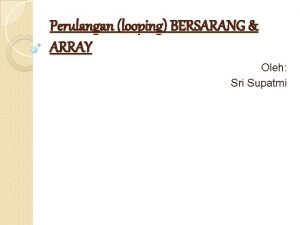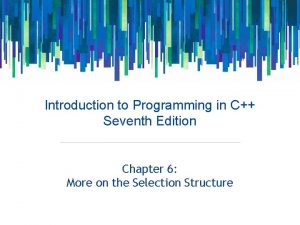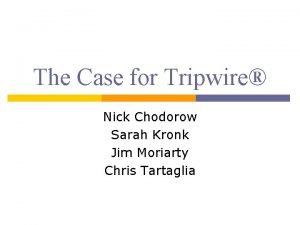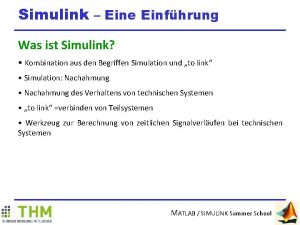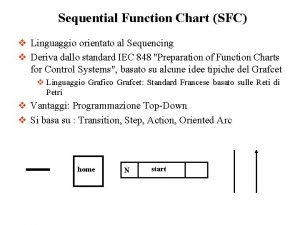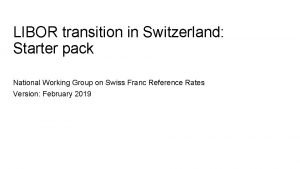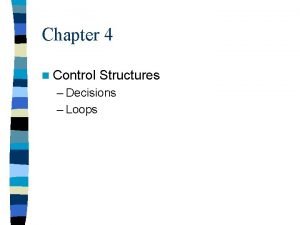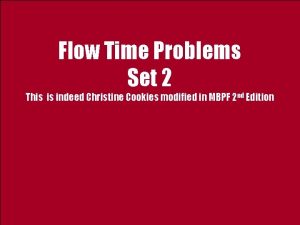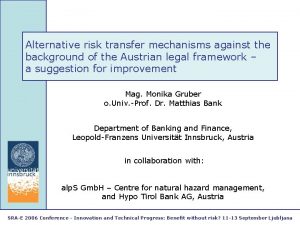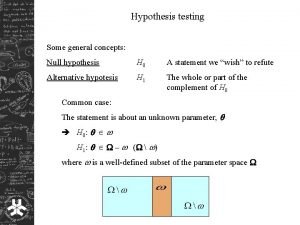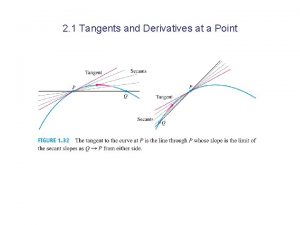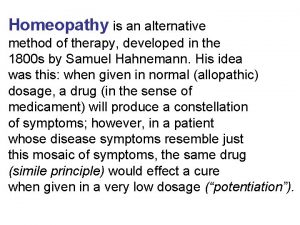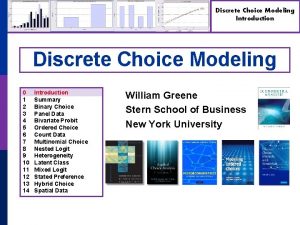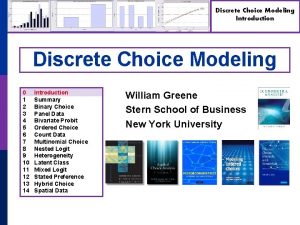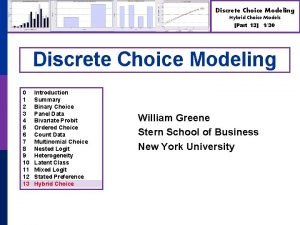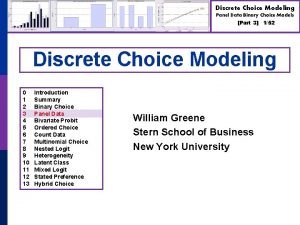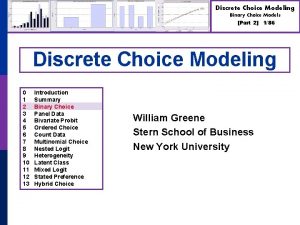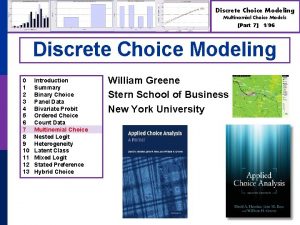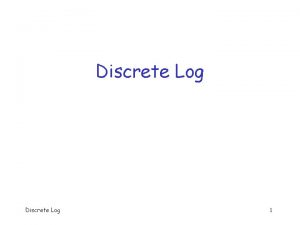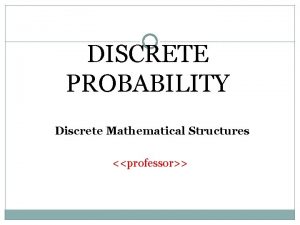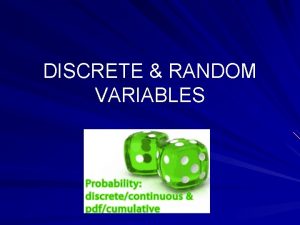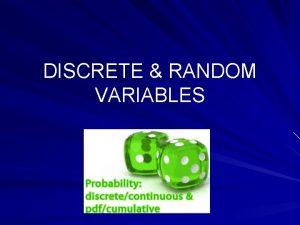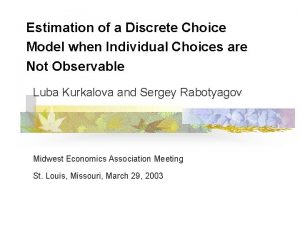Modeling of discrete choice n alternative Individual enumerates


























![Rにおける 尤度関数の定義と最大化 #対数尤度関数の定義 係数ベクトルxの関数と見なす. LL <- function (x){ vbus <- x[1] * tb + x[2] Rにおける 尤度関数の定義と最大化 #対数尤度関数の定義 係数ベクトルxの関数と見なす. LL <- function (x){ vbus <- x[1] * tb + x[2]](https://slidetodoc.com/presentation_image_h/dd48bd9139eb7be45962be23df1bc9da/image-27.jpg)
![Rによる推定結果の表示 > res $par [1] -0. 081037584 -0. 004007811 0. 369193890 $value [1] -5. Rによる推定結果の表示 > res $par [1] -0. 081037584 -0. 004007811 0. 369193890 $value [1] -5.](https://slidetodoc.com/presentation_image_h/dd48bd9139eb7be45962be23df1bc9da/image-28.jpg)






























- Slides: 58



離散的選択のモデル化 Modeling of discrete choice n 個人は,採りうる選択肢alternativeを列挙する Individual enumerates alternatives n 各選択肢の特徴と費用を考え、評価点をつける Assign evaluation points for each alternative. n 評価点が高いものを選ぶ Chose the alternative having the highest point China 60点 France 40点 USA 50点


確率的選択:評価点の差と選択率 Probablistic Choice n 実際には In many cases, n n 評価点に差が小さければ、どちらの選択肢も選ばれる可 能性がある Both alternatives are possibly chosen, if the difference of utility was not large. 評価点の差が大きいときは,片方しか選ばれない. 選択肢Aが選ばれる可能性 Probability of choice of A 1 Aが圧倒的に劣る Aが選ばれることはほとんどない Utility of A is very inferior to that of B, A is rarely chosen. 2つは同じ魅力 50%ずつ 0 Aが圧倒的に良い ほと んどAだけが選ばれる Utility of A is very superior to that of B, A is almost chosen. 選択肢Aの得点-選択肢Bの得点 Utility of A – Utility of B


2項ロジットモデル Binary (Binomial) Logit Model 選択肢が2つの場合 2項ロジットモデル When they have two alternatives n n 選択肢が多数(n個)ある場合 Many alternatives 多項ロジットモデル Multinomial Logit



比率によるロジットモデルの推定 Estimation of parameters in Logit model based on the aggregated shares n 集計的方法(集団の選択率にあわせる) ある選択肢の状況下で観測された集団の選択確率p を用いる Observed share n ロジットモデルから、その時の 2つの選択肢の魅力度 VAとVBの差が逆算できる Utility differences are reversely calculated to meet with the obsereved share of two alternatives. n 魅力度の差がうまく一致するように、魅力度の関数の 形を調整する Adjust the parameters (functions) such that the proper utility difference are obtained. n






2項ロジットモデルの図解 Scheme of binary logit model V* 1 V 0 X 2 X 1

集計データ(比率)を用いた ロジットモデルの推定 表 3. 15 バスの所要時間 表 3. 17 バスの所要費用 tBij c. Bij 1 2 3 1 5 11 13 2 10 12 3 14 16 表 3. 19 バスの分担率 1 2 3 1 130 140 180 12 2 140 130 7 3 180 220 PBij 1 2 3 1 0. 273 0. 265 0. 253 220 2 0. 282 0. 248 0. 255 130 3 0. 239 0. 192 0. 244 単位:分 単位:円 表 3. 16 自動車の所要時 間 表 3. 18 自動車の所要費用 表 3. 20 自動車の分担率 c. Cij PCij t. Cij 1 2 3 1 21 45 58 1 0. 727 0. 735 0. 747 1 3 8 10 2 45 42 60 2 0. 718 0. 752 0. 745 2 8 7 11 3 58 60 19 3 0. 761 0. 808 0. 756 3 10 11 3 単位:分 単位:円



Rによる線形回帰 Linear regression by R tb <- c(5, 10, 14, 11, 12, 16, 13, 12, 7) tc <- c(3, 8, 10, 8, 7, 11, 10, 11, 3) cb <- c(130, 140, 180, 140, 130, 220, 180, 220, 130) cc <- c(21, 45, 58, 45, 42, 60, 58, 60, 19) pb <- c(0. 273, 0. 282, 0. 239, 0. 265, 0. 248, 0. 192, 0. 253, 0. 255, 0. 244) pc <- rep(1, 9)-pb lnpbpc <- log(pc/pb) tsa <- tc-tb csa <- cc-cb ans <- lm(lnpbpc ~ tsa+csa) summary(ans)

Rによる線形回帰の推定結果 Result of linear regression Call: lm(formula = lnpbpc ~ tsa + csa) Residuals: Min 1 Q Median 3 Q Max -0. 021913 -0. 017819 -0. 006659 0. 018098 0. 030403 Coefficients: Estimate Std. Error t value Pr(>|t|) (Intercept) 0. 3898049 0. 0446483 8. 731 0. 000125 *** tsa -0. 0795878 0. 0060416 -13. 173 1. 18 e-05 *** csa -0. 0038682 0. 0003171 -12. 200 1. 85 e-05 *** --Signif. codes: 0 ‘***’ 0. 001 ‘**’ 0. 01 ‘*’ 0. 05 ‘. ’ 0. 1 ‘ ’ 1 Residual standard error: 0. 0237 on 6 degrees of freedom Multiple R-squared: 0. 9799, Adjusted R-squared: 0. 9732 F-statistic: 146 on 2 and 6 DF, p-value: 8. 165 e-06

最尤法によるロジットモデルの推定 Maximum Likelihood Estimation 表 3. 15 バスの所要時間 表 3. 17 バスの所要費用 tBij c. Bij 1 2 3 1 5 11 130 140 180 2 10 12 12 2 140 130 220 3 14 16 7 3 180 220 130 単位:分 単位:円 表 3. 16 自動車の所要時 間 表 3. 18 自動車の所要費用 t. Cij c. Cij 1 2 3 1 21 45 58 1 3 8 10 2 45 42 60 2 8 7 11 3 58 60 19 3 10 11 3 単位:分 単位:円




作成されたロジットモデル Estimated Logit model
![Rにおける 尤度関数の定義と最大化 対数尤度関数の定義 係数ベクトルxの関数と見なす LL function x vbus x1 tb x2 Rにおける 尤度関数の定義と最大化 #対数尤度関数の定義 係数ベクトルxの関数と見なす. LL <- function (x){ vbus <- x[1] * tb + x[2]](https://slidetodoc.com/presentation_image_h/dd48bd9139eb7be45962be23df1bc9da/image-27.jpg)
Rにおける 尤度関数の定義と最大化 #対数尤度関数の定義 係数ベクトルxの関数と見なす. LL <- function (x){ vbus <- x[1] * tb + x[2] * cb vcar <- x[1] * tc + x[2] * cc + x[3] ppb <- 1/(1+exp(vcar - vbus)) ppc <- 1 - ppb return(sum(pb*log(ppb)+pc*log(ppc))) } #Optim関数で最大化を行い,結果をresに代入する.初期値は(0, 0, 0) b 0=c(0, 0, 0) res<-optim(b 0, LL, method = "BFGS", hessian = TRUE, control=list(fnscale=-1))
![Rによる推定結果の表示 res par 1 0 081037584 0 004007811 0 369193890 value 1 5 Rによる推定結果の表示 > res $par [1] -0. 081037584 -0. 004007811 0. 369193890 $value [1] -5.](https://slidetodoc.com/presentation_image_h/dd48bd9139eb7be45962be23df1bc9da/image-28.jpg)
Rによる推定結果の表示 > res $par [1] -0. 081037584 -0. 004007811 0. 369193890 $value [1] -5. 047779 $counts function gradient 62 18 $convergence [1] 0 $message NULL $hessian [, 1] [, 2] [, 3] [1, ] -19. 628306 -613. 3939 5. 313007 [2, ] -613. 393875 -23980. 3173 196. 530577 [3, ] 5. 313007 196. 5306 -1. 681972

Rによる非集計最尤法の推定 Maximum Likelihood by R n 完全非集計データ(1サンプル 1行)の時 Pure disaggregate data (one line for one sample) n n glm(従属変数~独立変数1+・・・+独立変 数n, family=binomial(link=“logit”)) 従属変数が比率の場合 Share data n glm(従属変数~独立変数1+・・・+独立変 数n, family=quasibinomial(link=“logit”))

Rによる最尤法での推定 比率を説明する場合(share data) ans 2 <- glm(pc ~ tsa+csa, family=quasibinomial(link="logit")) summary(ans 2) Call: glm(formula = pc ~ tsa + csa, family = quasibinomial(link = "logit")) Deviance Residuals: Min 1 Q Median 3 Q Max -0. 008856 -0. 007615 -0. 002659 0. 007188 0. 013667 Coefficients: Estimate Std. Error t value Pr(>|t|) (Intercept) 0. 3991916 0. 0446219 8. 946 0. 000109 *** tsa -0. 0787542 0. 0060030 -13. 119 1. 21 e-05 *** csa -0. 0038095 0. 0003174 -12. 001 2. 03 e-05 *** --Signif. codes: 0 ‘***’ 0. 001 ‘**’ 0. 01 ‘*’ 0. 05 ‘. ’ 0. 1 ‘ ’ 1 (Dispersion parameter for quasibinomial family taken to be 0. 0001007740)

各個人の選択を説明する場合 Rにより,個人ごとのデータを作成 nb <- c(39, 11, 16, 22, 31, 15, 21, 25, 50) nc <- c(104, 28, 51, 61, 94, 63, 62, 73, 155) nn <- nb + nc nnf <-numeric(length=10) for (i in 1: 9){ nnf[i+1]=nnf[i]+nn[i] } chc <- numeric(length=nnf[10]-1) tim <- numeric(length=nnf[10]-1) cst <- numeric(length=nnf[10]-1) for (i in 1: 9){ chc[nnf[i]: (nnf[i]+nn[i]-1)] <- c(rep(1, nb[i]), rep(0, nc[i])) tim[nnf[i]: (nnf[i]+nn[i]-1)] <- rep((tb[i]-tc[i]), nn[i]) cst[nnf[i]: (nnf[i]+nn[i]-1)] <- rep((cb[i]-cc[i]), nn[i])

各個人の選択を説明する場合 pure disaggregate data ans 3 <- glm(chc ~ tim+cst, family=binomial(link="logit")) summary(ans 3) Call: glm(formula = chc ~ tim + cst, family = binomial(link = "logit")) Deviance Residuals: Min 1 Q Median 3 Q Max -0. 8215 -0. 7630 -0. 7470 -0. 1019 1. 8016 Coefficients: Estimate Std. Error z value Pr(>|z|) (Intercept) -0. 385889 0. 507795 -0. 760 0. 447 tim -0. 079514 0. 061803 -1. 287 0. 198 cst -0. 003873 0. 003465 -1. 118 0. 264 (Dispersion parameter for binomial family taken to be 1) Null deviance: 1034. 7 on 919 degrees of freedom Residual deviance: 1032. 4 on 917 degrees of freedom AIC: 1038. 4 Number of Fisher Scoring iterations: 4








ニュートン・ラプソン法 Newton Raphson Method

多項ロジットモデル Multinomial Logit Model





多項ロジットモデル用のデータ( 愛媛大学作成:)ehime. csv SEQ, 選択, 年齢, 保有台数, 鉄道可能性, 時間, 費用, バス可能性, 時間, 費用, 4輪可能性, 時間, 費用 3869, 1, 7, 5, 1, 37. 2 , 250, 1, 129. 0 , 850, 1, 25. 61, 120. 61 7447, 1, 7, 5, 1, 37. 2 , 250, 1, 121. 3 , 1174. 33, 1, 25. 61, 120. 61 7924, 1, 7, 5, 1, 42. 1 , 230, 1, 148. 3 , 960, 1, 29. 85, 142. 34 2460, 1, 5, 5, 1, 39. 0 , 230, 1, 106. 6 , 970, 1, 37. 06, 177. 84 3800, 1, 5, 5, 1, 39. 0 , 230, 1, 91. 3 , 850, 1, 37. 06, 177. 84 3347, 1, 3, 5, 1, 22. 0 , 140, 1, 77. 9 , 300, 1, 9. 41, 34. 04 4143, 1, 3, 5, 1, 22. 0 , 140, 1, 77. 9 , 300, 1, 9. 41, 34. 04 2529, 1, 1, 5, 1, 45. 0 , 320, 1, 94. 8 , 910, 1, 34. 42, 165. 4 4985, 1, 1, 5, 1, 45. 0 , 320, 1, 128. 5 , 1050, 1, 34. 42, 165. 39 6424, 1, 6, 4, 1, 83. 3 , 570, 1, 179. 8 , 1604. 61, 1, 62. 26, 511. 51 7791, 1, 6, 4, 1, 83. 3 , 570, 1, 172. 0 , 1720, 1, 62. 26, 511. 51 1498, 1, 5, 4, 1, 43. 6 , 650, 1, 169. 3 , 1932. 33, 1, 77. 59, 400. 49 1962, 1, 5, 4, 1, 54. 1 , 609, 1, 136. 0 , 1182. 28, 1, 61. 78, 313. 43 2367, 1, 5, 4, 1, 120. 3 , 1100, 1, 112. 2 , 1449. 06, 1, 60. 44, 306. 36 2369, 1, 5, 4, 1, 120. 3 , 1100, 1, 112. 2 , 1449. 06, 1, 60. 44, 306. 36 3985, 1, 5, 4, 1, 54. 1 , 609, 1, 134. 2 , 1182. 28, 1, 61. 78, 313. 43 4307, 1, 5, 4, 1, 43. 6 , 650, 1, 183. 8 , 2082. 33, 1, 77. 59, 400. 49 4931, 1, 5, 4, 1, 155. 0 , 1100, 1, 143. 1 , 1449. 06, 1, 60. 44, 306. 36 4932, 1, 5, 4, 1, 155. 0 , 1100, 1, 143. 1 , 1449. 06, 1, 60. 44, 306. 36 4701, 1, 1, 4, 1, 54. 7 , 320, 1, 105. 9 , 1020, 1, 31. 65, 160. 45 5774, 1, 1, 4, 1, 29. 7 , 180, 1, 67. 4 , 450, 1, 14. 63, 61. 37 6840, 1, 1, 4, 1, 29. 7 , 180, 1, 97. 8 , 450, 1, 14. 63, 61. 37 7242, 1, 1, 4, 1, 54. 7 , 320, 1, 98. 9 , 882. 17, 1, 31. 65, 160. 45 2368, 1, 7, 3, 1, 120. 3 , 1100, 1, 112. 2 , 1449. 06, 1, 60. 44, 306. 36 3309, 1, 7, 3, 1, 75. 7 , 570, 1, 167. 2 , 1460, 1, 58. 17, 497. 65 4662, 1, 7, 3, 1, 18. 0 , 140, 1, 70. 4 , 160, 1, 6. 81, 20. 01 4830, 1, 7, 3, 1, 35. 3 , 296, 1, 95. 3 , 440, 1, 20. 37, 92. 23 4933, 1, 7, 3, 1, 155. 0 , 1100, 1, 143. 1 , 1449. 06, 1, 60. 44, 306. 36 4980, 1, 7, 3, 1, 33. 7 , 190, 1, 125. 1 , 800, 1, 22. 24, 102. 38

多項ロジットモデルの最尤法プ ログラム(愛媛大学作成:) ### Multi Nomial Logit (MNL) estimation program (Original code by EHIME University) ###データファイルの読み込み Data<-read. csv("ehime. csv", header=T) hh<-nrow(Data) ##データ数: Data の行数を数える print(hh) ch<- 3 ##今回用いる選択肢の数 b 0<-c(0, 0, 0, 0) Srail <- sum(Data[, 14]== 1); Sbus <- sum(Data[, 14]== 2); Scar <- sum(Data[, 14]== 3) cat("rail: ", Srail, " bus: ", Sbus, " car: ", Scar, "n") ## Logit model の対数尤度関数の定義 fr <- function(x) { LL=0 ##効用の計算 rail <- x[1]*Data[, 6]/100 + x[2]*Data[, 7]/100 + x[5]*matrix(1, nrow =hh, ncol=1) bus <- x[1]*Data[, 9]/100 + x[2]*Data[, 10]/100 + x[3]*(Data[, 3]>=6) + x[6]*matrix(1, nrow=hh, ncol=1) car <- x[1]*Data[, 12]/100 + x[2]*Data[, 13]/100 + x[4]*(Data[, 4]>=2) ##効用の指数化 Erail <- exp(rail)*Data[, 5] Ebus <- exp(bus )*Data[, 8] Ecar <- exp(car )*Data[, 11] PPrail <- Erail/(Erail+Ebus+Ecar) PPbus <- Ebus /(Erail+Ebus+Ecar) PPcar <- Ecar /(Erail+Ebus+Ecar) ##選択結果の確率のみを有効化 Prail <- (PPrail!=0)*PPrail + (PPrail==0) Pbus <- (PPbus !=0)*PPbus + (PPbus ==0) Pcar <- (PPcar !=0)*PPcar + (PPcar ==0) ##選択結果 Crail <- Data[, 14]== 1

多項ロジットモデルの 最尤法による推定結果 rail: 493 bus: 432 car: 708 roh = 0. 2432912 rohbar= 0. 2398755 $par [1] -1. 7411817 -0. 1757195 1. 7302273 2. 5890795 2. 0644240 2. 3457336 $value [1] -1329. 232 $counts function gradient 38 14 $convergence [1] 0 $message NULL $hessian [, 1] [, 2] [, 3] [, 4] [, 5] [, 6] [1, ] -80. 15815 -538. 9584 -67. 42988 65. 52220 27. 40143 -114. 7780 [2, ] -538. 95843 -4708. 3230 -493. 74059 503. 37025 123. 55640 -800. 5406 [3, ] -67. 42988 -493. 7406 -127. 96682 31. 64655 79. 67259 -127. 9668 [4, ] 65. 52220 503. 3703 31. 64655 -214. 17601 136. 44173 77. 7343 [5, ] 27. 40143 123. 5564 79. 67259 136. 44173 -293. 24442 123. 6202 [6, ] -114. 77804 -800. 5406 -127. 96682 77. 73429 123. 62021 -224. 7471 [1] -5. 857365 -5. 520454 12. 528884 17. 136179 13. 928912 10. 259022


多項ロジットモデル (パッケージ) Multinomial Logit Model install. packages("mlogit") library("mlogit") Dehime<-read. csv("ehime. csv", header=T) Ehime <-mlogit. data(Dehime, varying=c(5: 13), shape="wide", choice="choice") #MNL without constant term summary(mlogit(choice~time+cost-1, data=Ehime)) #MNL with constant term summary(mlogit(choice~time+cost, data=Ehime))

多項ロジットモデル(定数項なし) Multinomial Logit Model Call: mlogit(formula = Choice ~ time + cost - 1, data = Ehime) Frequencies of alternatives: bus car rail 0. 26454 0. 43356 0. 30190 Newton-Raphson maximisation gradient close to zero. May be a solution 5 iterations, 0 h: 0 m: 0 s g'(-H)^-1 g = 7. 47 E-31 Coefficients : Estimate Std. Error t-value Pr(>|t|) time -0. 00329405 0. 00197725 -1. 6660 0. 0957185. cost -0. 00096882 0. 00025323 -3. 8259 0. 0001303 *** --Signif. codes: 0 ‘***’ 0. 001 ‘**’ 0. 01 ‘*’ 0. 05 ‘. ’ 0. 1 ‘ ’ 1 Log-Likelihood: -1715. 7

多項ロジットモデル(定数項あり) Multinomial Logit Model Call: mlogit(formula = Choice ~ time + cost, data = Ehime) Frequencies of alternatives: bus car rail 0. 26454 0. 43356 0. 30190 Newton-Raphson maximisation gradient close to zero. May be a solution 5 iterations, 0 h: 0 m: 0 s g'(-H)^-1 g = 9. 17 E-26 Coefficients : Estimate Std. Error t-value Pr(>|t|) altcar -1. 07985435 0. 14856671 -7. 2685 3. 635 e-13 altrail -0. 95903599 0. 11625041 -8. 2497 2. 220 e-16 time -0. 01607098 0. 00261456 -6. 1467 7. 910 e-10 cost -0. 00119568 0. 00027125 -4. 4081 1. 043 e-05 Log-Likelihood: -1680. 5 Mc. Fadden R^2: 0. 68776 Likelihood ratio test : chisq = 152. 13 (p. value=< 2. 22 e-16 *** ***





ネスティッドロジットモデルの最尤 法プログラム(愛媛大学作成:) ### Nested Logit estimation program (Original code by EHIME University) ###データファイルの読み込み Data<-read. csv(“ehime. csv", header=T) hh<-nrow(Data) ##データ数: Data の行数を数える print(hh) ch<- 3 ##今回用いる選択肢の数 b 0<-c(0, 0, 0, 1) ##初期パラメータ値(全て 0) ## サンプルにおける各選択肢のシェア Srail <- sum(Data[, 2]==“rail”); Sbus <- sum(Data[, 2]==“ bus”); Scar <- sum(Data[, 2]==“car”) cat("rail: ", Srail, " bus: ", Sbus, " car: ", Scar, "n") ## Logit model の対数尤度関数の定義 fr <- function(x) { LL=0 ##効用の計算 rail <- x[1]*Data[, 6]/100 + x[2]*Data[, 7]/100 + x[5]*matrix(1, nrow =hh, ncol=1) bus <- x[1]*Data[, 9]/100 + x[2]*Data[, 10]/100 + x[3]*(Data[, 3]>=6) + x[6]*matrix(1, nrow =hh, ncol=1) car <- x[1]*Data[, 12]/100 + x[2]*Data[, 13]/100 + x[4]*(Data[, 4]>=2) ##効用の指数化 Erail <- exp(rail)*Data[, 5] Ebus <- exp(bus )*Data[, 8] Ecar <- exp(car )*Data[, 11]

 Dimensional modeling vs relational modeling
Dimensional modeling vs relational modeling Modeling and role modeling theory
Modeling and role modeling theory Modeling computation discrete math
Modeling computation discrete math Discrete modeling
Discrete modeling Discrete choice model python
Discrete choice model python Good choice or bad choice
Good choice or bad choice Individual choices
Individual choices Holistic medicine ehr
Holistic medicine ehr Ppt on alternative sources of energy
Ppt on alternative sources of energy Alternative metabolic pathways
Alternative metabolic pathways Flow time analysis
Flow time analysis Social movement examples
Social movement examples 2060 alternative
2060 alternative Gephi tool
Gephi tool Bureau of alternative learning system
Bureau of alternative learning system Storyworth alternative
Storyworth alternative Tk solver free
Tk solver free Feminax ultra alternative
Feminax ultra alternative Llojet e gjeneratorit
Llojet e gjeneratorit First conditional sentences
First conditional sentences Is nested loops bad
Is nested loops bad Multiple alternative selection structure
Multiple alternative selection structure Wvde certification forms
Wvde certification forms Alternative splicing animation
Alternative splicing animation Alternative channels of distribution
Alternative channels of distribution Claytargetscoring
Claytargetscoring Characteristics of effective tools for evaluation
Characteristics of effective tools for evaluation Quantopian alternative
Quantopian alternative Tripwire alternative
Tripwire alternative Simulink alternative
Simulink alternative Mz tools alternative
Mz tools alternative Alternative courses of action advantages and disadvantages
Alternative courses of action advantages and disadvantages Alternative operating systems
Alternative operating systems Linguaggio sfc
Linguaggio sfc Virtual reality remote maintenance
Virtual reality remote maintenance Chapter 32 complementary and alternative therapies
Chapter 32 complementary and alternative therapies Resursele hidrosferei
Resursele hidrosferei Alternative time
Alternative time Alternative forms of business organization
Alternative forms of business organization Alternative subcultures
Alternative subcultures Alternative complement pathway
Alternative complement pathway Redeapp alternative
Redeapp alternative Planning alternative tomorrows with hope
Planning alternative tomorrows with hope Swiss starter pack
Swiss starter pack Community alternative sentencing center
Community alternative sentencing center Ncontrol alternative
Ncontrol alternative Veyon
Veyon Geocaching swiss army knife
Geocaching swiss army knife Theoretical flow time formula
Theoretical flow time formula Fuel pressure regulator diagram
Fuel pressure regulator diagram Alternative risk transfer mechanisms
Alternative risk transfer mechanisms Classification alternative techniques in data mining
Classification alternative techniques in data mining Maxcut alternative
Maxcut alternative Null hypothesis example
Null hypothesis example Alternative marketing channels
Alternative marketing channels Regiograph strategie
Regiograph strategie Ibis 4 alternative
Ibis 4 alternative Alternative derivative formula
Alternative derivative formula Homeopathy the alternative
Homeopathy the alternative


